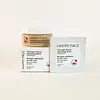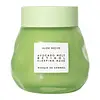What's inside
What's inside
 Key Ingredients
Key Ingredients

 Benefits
Benefits

 Concerns
Concerns

No concerns
 Ingredients Side-by-side
Ingredients Side-by-side

Water
Skin ConditioningCamellia Sinensis Leaf Extract
AntimicrobialCaprylic/Capric Triglyceride
MaskingHamamelis Virginiana Bark/Leaf Extract
AstringentHydrolyzed Collagen
EmollientMagnesium Ascorbyl Phosphate
AntioxidantTocopheryl Acetate
AntioxidantFerula Assa Foetida Root Extract
PerfumingGluconolactone
Skin ConditioningAcrylates/C10-30 Alkyl Acrylate Crosspolymer
Emulsion StabilisingCalcium Pantothenate
Cetearyl Glucoside
EmulsifyingLauryl Lactate
EmollientSorbitol
Humectant1,2-Hexanediol
Skin ConditioningCaprylyl Glycol
EmollientTropolone
Skin ConditioningSodium Benzoate
MaskingButylene Glycol
HumectantEthoxydiglycol
HumectantHyaluronic Acid
HumectantWater, Camellia Sinensis Leaf Extract, Caprylic/Capric Triglyceride, Hamamelis Virginiana Bark/Leaf Extract, Hydrolyzed Collagen, Magnesium Ascorbyl Phosphate, Tocopheryl Acetate, Ferula Assa Foetida Root Extract, Gluconolactone, Acrylates/C10-30 Alkyl Acrylate Crosspolymer, Calcium Pantothenate, Cetearyl Glucoside, Lauryl Lactate, Sorbitol, 1,2-Hexanediol, Caprylyl Glycol, Tropolone, Sodium Benzoate, Butylene Glycol, Ethoxydiglycol, Hyaluronic Acid
Water
Skin ConditioningPropanediol
SolventGlycerin
HumectantCetearyl Alcohol
EmollientGlyceryl Stearate
EmollientC9-12 Alkane
SolventCaprylic/Capric Triglyceride
MaskingKaolin
AbrasivePersea Gratissima Oil
Skin ConditioningPolyisobutene
Sodium Lauroyl Glutamate
Stearic Acid
CleansingC13-15 Alkane
SolventPlatonia Insignis Seed Butter
EmollientPersea Gratissima Fruit Extract
EmollientHyaluronic Acid
HumectantSodium Hyaluronate
HumectantSqualane
EmollientChamomilla Recutita Flower Extract
MaskingCamellia Sinensis Leaf Extract
AntimicrobialSaccharide Isomerate
HumectantHexylresorcinol
AntimicrobialZingiber Officinale Root Extract
MaskingOryza Sativa Extract
AbsorbentTocopheryl Acetate
AntioxidantGluconolactone
Skin ConditioningAloe Barbadensis Leaf Juice
Skin ConditioningMalachite Extract
AntioxidantEthylhexyl Palmitate
EmollientButylene Glycol
HumectantSodium Chloride
MaskingSodium Hydroxypropylsulfonate Laurylglucoside Crosspolymer
CleansingMaltodextrin
AbsorbentHydrated Silica
AbrasiveCurcumin
AntioxidantEthylhexylglycerin
Skin ConditioningPPG-3 Benzyl Ether Myristate
EmollientMaltooligosyl Glucoside
Skin ConditioningHydrogenated Starch Hydrolysate
HumectantRetinol
Skin ConditioningSpirulina Maxima Extract
SmoothingSodium Phosphate
BufferingPei-10
Citric Acid
BufferingSodium Citrate
BufferingSodium Dilauramidoglutamide Lysine
HumectantPotassium Phosphate
BufferingPotassium Chloride
Silica Dimethyl Silylate
EmollientArginine
MaskingSodium Hydroxide
BufferingCaprylyl Glycol
EmollientTocopherol
AntioxidantRosmarinus Officinalis Leaf Extract
AntimicrobialLavandula Angustifolia Flower/Leaf/Stem Extract
MaskingHexylene Glycol
EmulsifyingAcrylates/C10-30 Alkyl Acrylate Crosspolymer
Emulsion StabilisingPotassium Sorbate
PreservativeCarthamus Tinctorius Seed Extract
Skin ConditioningAroma
Pvp
Emulsion StabilisingSodium Benzoate
MaskingPhenoxyethanol
PreservativeParfum
MaskingWater, Propanediol, Glycerin, Cetearyl Alcohol, Glyceryl Stearate, C9-12 Alkane, Caprylic/Capric Triglyceride, Kaolin, Persea Gratissima Oil, Polyisobutene, Sodium Lauroyl Glutamate, Stearic Acid, C13-15 Alkane, Platonia Insignis Seed Butter, Persea Gratissima Fruit Extract, Hyaluronic Acid, Sodium Hyaluronate, Squalane, Chamomilla Recutita Flower Extract, Camellia Sinensis Leaf Extract, Saccharide Isomerate, Hexylresorcinol, Zingiber Officinale Root Extract, Oryza Sativa Extract, Tocopheryl Acetate, Gluconolactone, Aloe Barbadensis Leaf Juice, Malachite Extract, Ethylhexyl Palmitate, Butylene Glycol, Sodium Chloride, Sodium Hydroxypropylsulfonate Laurylglucoside Crosspolymer, Maltodextrin, Hydrated Silica, Curcumin, Ethylhexylglycerin, PPG-3 Benzyl Ether Myristate, Maltooligosyl Glucoside, Hydrogenated Starch Hydrolysate, Retinol, Spirulina Maxima Extract, Sodium Phosphate, Pei-10, Citric Acid, Sodium Citrate, Sodium Dilauramidoglutamide Lysine, Potassium Phosphate, Potassium Chloride, Silica Dimethyl Silylate, Arginine, Sodium Hydroxide, Caprylyl Glycol, Tocopherol, Rosmarinus Officinalis Leaf Extract, Lavandula Angustifolia Flower/Leaf/Stem Extract, Hexylene Glycol, Acrylates/C10-30 Alkyl Acrylate Crosspolymer, Potassium Sorbate, Carthamus Tinctorius Seed Extract, Aroma, Pvp, Sodium Benzoate, Phenoxyethanol, Parfum
Alternatives
Ingredients Explained
These ingredients are found in both products.
Ingredients higher up in an ingredient list are typically present in a larger amount.
Acrylates/C10-30 Alkyl Acrylate Crosspolymer is a synthetic polymer. It is used to thicken and improve the texture of products. Due to its properties, it can prevent water and oil ingredients from separating.
Butylene Glycol (or BG) is used within cosmetic products for a few different reasons:
Overall, Butylene Glycol is a safe and well-rounded ingredient that works well with other ingredients.
Though this ingredient works well with most skin types, some people with sensitive skin may experience a reaction such as allergic rashes, closed comedones, or itchiness.
Learn more about Butylene GlycolCamellia Sinensis Leaf Extract is derived from the leaves of the tea plant. Black tea, green tea, and oolong tea are all harvested from this plant.
This ingredient has many skin benefits:
This ingredient contains polyphenols, a strong antioxidant. Antioxidants help fight off molecules that damage skin cells.
On top of that, the antioxidants in green tea neutralize free-radicals from the sun. This gives the skin some extra UV protection, but should not replace sunscreen.
Many components of tea have anti-inflammatory properties.
Polyphenols and L-theanine help soothe the skin and reduce irritation. The caffeine in Camellia Sinensis Leaf Extract helps calm inflamed blood vessels.
Other compounds found in tea include: Vitamin Bs, linoleic acid, magnesium, calcium, iron, and zinc.
Research has shown both drinking Camellia Sinensis Leaf Tea and applying it to the skin can help boost skin elasticity and hydration. Studies also show using tea extract may reduce sebum, or oil, production.
Learn more about Camellia Sinensis Leaf ExtractThis ingredient is an emollient, solvent, and texture enhancer. It is considered a skin-softener by helping the skin prevent moisture loss.
It helps thicken a product's formula and makes it easier to spread by dissolving clumping compounds.
Caprylic Triglyceride is made by combining glycerin with coconut oil, forming a clear liquid.
While there is an assumption Caprylic Triglyceride can clog pores due to it being derived from coconut oil, there is no research supporting this.
Learn more about Caprylic/Capric TriglycerideCaprylyl Glycol is a humectant and emollient, meaning it attracts and preserves moisture.
It is a common ingredient in many products, especially those designed to hydrate skin. The primary benefits are retaining moisture, skin softening, and promoting a healthy skin barrier.
Though Caprylyl Glycol is an alcohol derived from fatty acids, it is not the kind that can dry out skin.
This ingredient is also used as a preservative to extend the life of products. It has slight antimicrobial properties.
Learn more about Caprylyl GlycolGluconolactone is a PHA. PHAs are a great gentle alternative to traditional AHAs.
When applied, Gluconolactone has the same affect on skin as AHAs such as lactic acid. It helps dissolve the dead skin cells in the top layer of your skin. This improves texture and brightens the skin.
PHAs are more gentle than AHAs due to their larger structure. They do not penetrate as deeply as AHAs and take a longer time to dissolve dead cells. Studies show PHAs do not cause as much irritation.
Gluconolactone has some interesting properties:
In a 2004 study, Gluconolactone was found to prevent UV damage in mouse skin cells and has not been found to increase sun sensitivity. However, we still recommend wearing SPF daily.
This ingredient is is an created by reacting gluconic acid with an alcohol.
Learn more about GluconolactoneHyaluronic acid is naturally found in healthy skin. It is a humectant, meaning it draws moisture to your skin.
This ingredient helps hydrate, soothe, and protect the skin.
What makes hyaluronic acid so hydrating? It has the capacity to bind or hold large amounts of water.
Fun fact: It is already naturally found in our bodies, such as the fluids of our eyes and our joints.
Studies find this ingredient to have anti-inflammatory and anti-microbial properties. This can help speed up wound-healing.
Hyaluronic acid can be irritating if the molecule has a low-molecular weight, or if the molecules are small.
One study found low-molecular weight hyaluronic acid to be pro-inflammatory, meaning some people may experience irritation. This is because our bodies use hyaluronic acid in the wound-healing process to signal to our bodies, via irritation, that something needs healing.
The same study found high-molecular weight hyaluronic acid to be anti-inflammatory.
These are some other common types of Hyaluronic Acid:
Learn more about Hyaluronic AcidSodium Benzoate is a preservative. It's used in both cosmetic and food products to inhibit the growth of mold and bacteria. It is typically produced synthetically.
Both the US FDA and EU Health Committee have approved the use of sodium benzoate. In the US, levels of 0.1% (of the total product) are allowed.
Sodium benzoate works as a preservative by inhibiting the growth of bacteria inside of cells. It prevents the cell from fermenting a type of sugar using an enzyme called phosphofructokinase.
It is the salt of benzoic acid. Foods containing sodium benzoate include soda, salad dressings, condiments, fruit juices, wines, and snack foods.
Studies for using ascorbic acid and sodium benzoate in cosmetics are lacking, especially in skincare routines with multiple steps.
We always recommend speaking with a professional, such as a dermatologist, if you have any concerns.
Learn more about Sodium BenzoateTocopheryl Acetate is AKA Vitamin E. It is an antioxidant and protects your skin from free radicals. Free radicals damage the skin by breaking down collagen.
One study found using Tocopheryl Acetate with Vitamin C decreased the number of sunburned cells.
Tocopheryl Acetate is commonly found in both skincare and dietary supplements.
Learn more about Tocopheryl AcetateWater. It's the most common cosmetic ingredient of all. You'll usually see it at the top of ingredient lists, meaning that it makes up the largest part of the product.
So why is it so popular? Water most often acts as a solvent - this means that it helps dissolve other ingredients into the formulation.
You'll also recognize water as that liquid we all need to stay alive. If you see this, drink a glass of water. Stay hydrated!
Learn more about Water